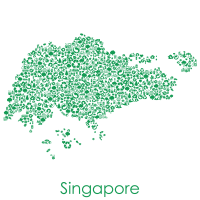2. Strategy for green development
The “Singapore Green Plan 2030”, launched in February 2021, involves five ministries (Ministry of Sustainability and Environment MSE, Ministry of Trade and Industry MTI, Ministry of Transport MOT, Ministry of National Development MND and Ministry of Education MOE) and constitutes the policy guidance document of the entire Government 1.
The Plan is based on five “pillars”, for each of which specific short, medium and long-term objectives are defined.
City in Nature envisages expanding the network of nature parks, restoring nature to the urban landscape, and improving veterinary care and animal management.
-
By 2026, the goal is to expand the green parks by 130 hectares and improve the vegetation of 170 existing hectares.
-
By 2030, the goal is to plant one million new trees, increase the area dedicated to green parks by 50% compared to 2020, so that every home is within a ten-minute walk of a park.
-
By 2035, the goal is to have added 1,000 hectares of green space.
Energy Reset aims to use cleaner energy across all sectors, in particular by increasing the production of energy from renewable sources (currently most electricity comes from natural gas power plants), the development of solar and energy storage systems (ESS), the development of green and sustainable infrastructure construction and the development of green mobility.
-
The 2025 targets include deploying 1.5 GW of solar (equivalent to 2% of energy demand, equivalent to 260,000 homes), deploying 200 MWh from ESS systems to improve grid stability, reducing desalination energy consumption from 3.5 kWh/m3 to 2 kWh/ m3 (-42.9%) and bringing the Tuas plant Integrated waste and sewage management nexus to full energy self-sufficiency, waiving the registration of new diesel vehicles, and installing electric vehicle charging stations in all HDB village car parks, limiting the purchase of new electric-powered Changi Airport service vehicles.
-
The 2030 targets include achieving 2GW of solar installed capacity (3% of expected demand, equivalent to 350,000 homes), fully implementing the 80-80-80 master plan (greening 80% of the entire building stock through energy efficiency and new sustainability standards, 80% improvement in energy performance of the best buildings, 80% of new buildings to be SLE – super low energy consumption), reducing desalination energy consumption to 1kWh/m3 , reducing HDB villages’ energy consumption by 15%, installing 60,000 electric vehicle charging points and limiting the registration of new cars and taxis to cleaner energy models, making all harbour vessels fully electric or capable of using B100 biofuel (100% biodiesel) or zero-emission fuel.
-
The 2040 targets include phasing out all less clean energy vehicles and transitioning all Changi Airport service vehicles to electric .
Sustainable Living includes reducing carbon emissions, reducing consumption, increasing waste recycling and improving public transportation. The vision is to become a Zero Waste nation powered by a circular economy, with the 3R paradigm (Reduce, Reuse and Recycle) as the norm for citizens and businesses.
-
By 2026, the goal is to reduce daily landfill disposal per capita by 20%.
-
By 2030, the goals are to reduce per capita daily water consumption to 130 litres and reduce per capita daily landfill disposal by 30%, reach 75% of the modal share of passenger transport, during peak periods, on public transport, convert 50% of the bus fleet to electric, expand rail transport by 360 kilometres, expand cycle paths to around 1,300 kilometres, reduce carbon emissions from the school sector by two-thirds and bring at least 20% of schools to carbon neutrality.
-
By 2040, replace all diesel buses with cleaner-powered vehicles, reach 80% of the modal share of passenger transport, during peak periods, on public transport, ensure that 9 out of 10 transfers take place on public transport or by active mobility (walking and non-motorized vehicles) and shared mobility.
Green Economy aims to pursue green growth to create new jobs, transform industries and leverage sustainability as a competitive advantage. The Singapore Economic Development Board – EDB 2and the National Energy Agency 3manage funds to provide concessional loans and grants to businesses to undertake the path of decarbonisation and energy efficiency . Under the RIE ( Research , Innovation, Enterprise) programme 4, the Government renews its support for the development and commercialisation of innovative solutions related to sustainability, such as clean and renewable energy, circular economy and low-carbon solutions. The enterprise development agency, Enterprise Singapore – ESG, has launched the Enterprise Sustainability Programme 5, to support the skills and capabilities of Small and Medium Enterprises in the sectors of sustainability.
-
The 2030 goals include transforming Jurong Island into a sustainable chemicals and energy park, establishing Singapore as a sustainable tourism destination, establishing Singapore as a financial and services hub to support Asia's transition to a sustainable and low-carbon future, and as an Asian regional development hub for the development of sustainable solutions, by growing a strong pipeline of local companies.
Resilient Future is the set of programmatic measures primarily aimed at addressing sea level rise, ensuring food security and addressing urban overheating .
-
By 2030, specific goals include completing the East Coast Protection Plan, the North West Coast Protection Plan and the Jurong Island Protection Plan , increasing agri-food self-production to 30% of the national nutritional requirement, installing a widespread sensor network for climate and temperature recording to implement building temperature mitigation strategies.
1https://www.greenplan.gov.sg/overview/
2https://www.edb.gov.sg/en/grants/incentives-and-schemes.html
3https://www.nea.gov.sg/programmes-grants
4https://www.nrf.gov.sg/rie-ecosystem/ecosystem/
5https://www.enterprisesg.gov.sg/grow-your-business/boost-capabilities/sustainability/enterprise-sustainability-programme
